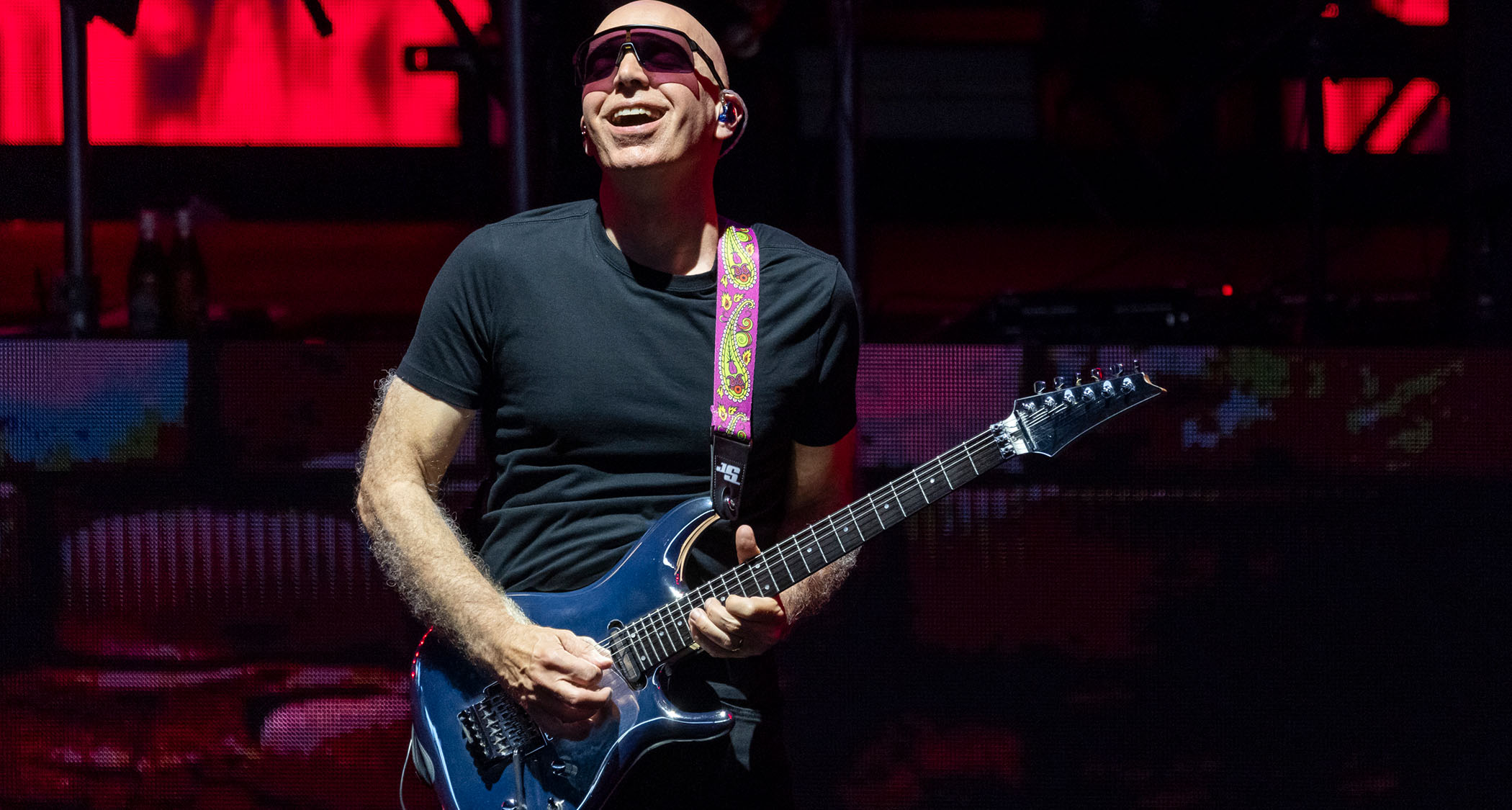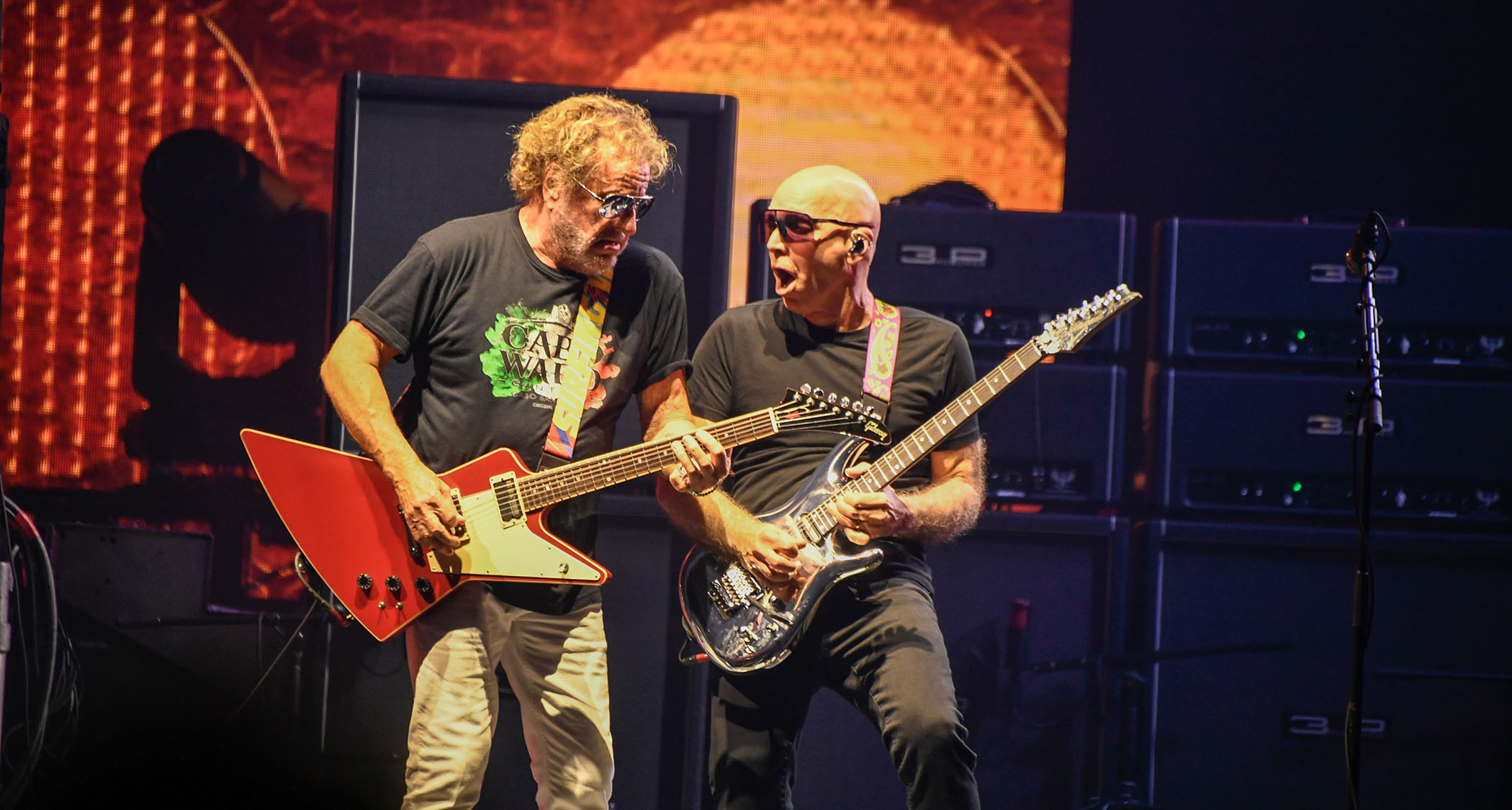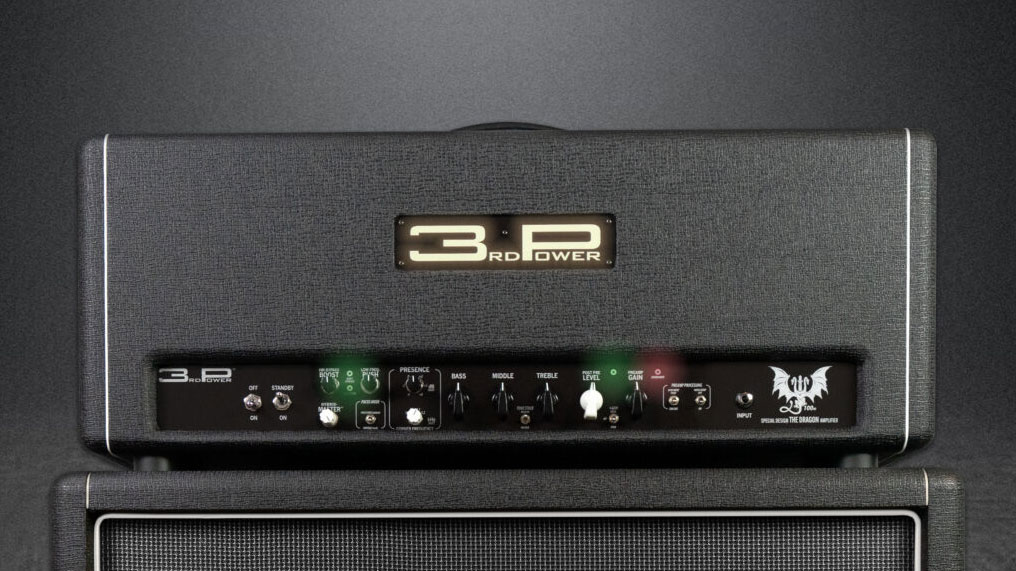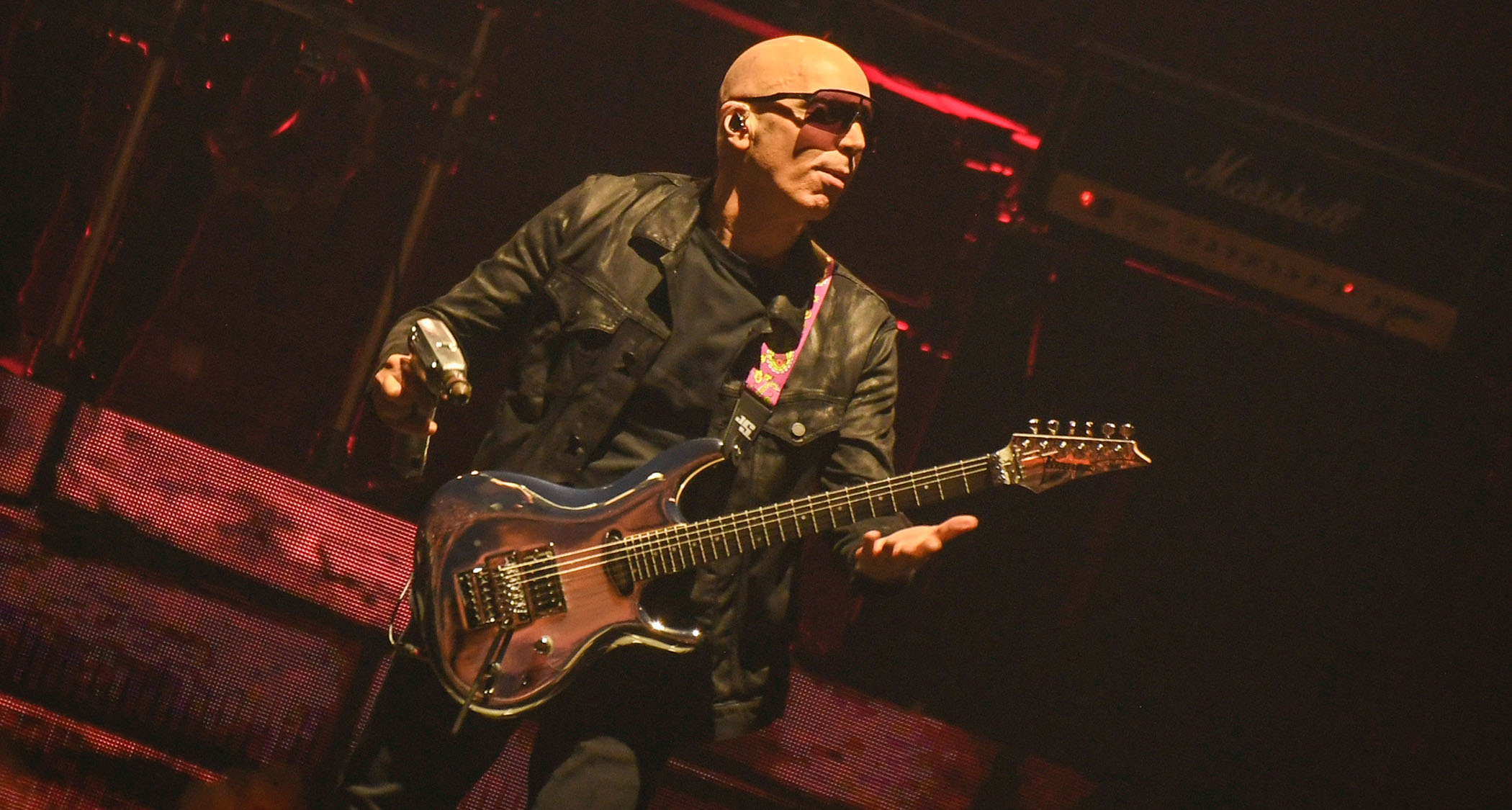
Few guitarists, let alone a virtuoso like Joe Satriani, would dare to touch on the legacy of Edward Van Halen. Insinuating as much usually gets fans hot and bothered – and that’s been the case since rumors of Satch paying homage to King Edward began to swirl in 2022.
That was different, though, as it featured David Lee Roth and Alex Van Halen. But things changed when Satch’s old pal, Chickenfoot bandmate and former EVH cohort, Sammy Hagar, came calling with his version of Van Halen (and more) tribute-paying, The Best Of All Worlds Tour – alongside Michael Anthony and Jason Bonham.
“The vibe on tour has been great,” Satriani tells Guitarist. “It’s a party, but everyone expects everybody to play their best each night. There’s this beautiful anticipation before every show to celebrate the legacy. And the fans’ reaction has been heartwarming.”
As Satriani is tasked with the impossible, to imitate EVH, the fan reaction is important.
“I’m just speaking for myself,” he says. “But I feel it. I’m not the guy who says, ‘I’m the only [one] that can do it.’ None of that bullshit. I want to do it right. I spent all this money on gear and want to make it a great night to celebrate these songs. And I think everybody gets it.”
Satriani’s mindset is also heartwarming. The idea that he’d set aside his iconic style and cache of songs to pay Eddie his due is the secret to why he’s the man for the job. But in true Satch fashion, he’s managed to do it so that his and Eddie’s worlds happily collide.
“I’m throwing in all the stuff I normally would,” he says. “But I’ve added some things I never really did because I thought, ‘Well, that’s Eddie. I’m not gonna copy that.’ It doesn’t come naturally to me, but I’ve made it work. Though I’m not copying the parts; that’s not me, I’m not in a tribute band.”
While there are more shows to come – and they are yet to be announced – Satriani is already feeling a sense of gratitude for being a part of it and a deeper appreciation for EVH.
“There are moments when I have to center myself,” he admits. “I’ll say, ‘Okay, switch guitars, step on that thing, reduce the chorus, increase the delay,’ you know… keep it together [laughs]. It’s like I’ve said all along: what I do is not a real job, but somebody’s gotta do it.”

A couple of years ago, as rumors of you doing something Van Halen-related were percolating, you said something to the effect of “not wanting any part of it” when you were first approached.
“When Alex [Van Halen] and Dave [Lee Roth] first approached me to do it, I said, ‘Yes.’ Three weeks later, I called Alex back and said, ‘No way. I can’t do this. This is too hard.’ But he convinced me that I could do it, and then another couple of weeks later, it was the same kind of thing. I thought, ‘Man, some of these songs are… they’re just not me.’
I’ve added some things I never really did because I thought, ‘Well, that’s Eddie. I’m not gonna copy that’
“Eddie played in a completely different way. Where he put his timing… it’s so different from what I cultivated in my playing for decades. So that was the hardest part; I was just always pushing like Eddie did, and I was always trying to find the deepest pocket.
“Once Wolfgang [Van Halen] started to play some stuff out, I realised that was kind of the closure the fans needed; that’s what we all needed. That was the best tribute show ever. Watching Wolfgang lovingly play a couple of famous EVH songs had a big effect on me because I wanted closure, too.
“So, out of the blue, when Sammy called… and I should preface this by saying when Sammy calls you, you don’t really get a word in edgewise for a while! It was one of those calls where I just listened for a long time, but when he was done, I heard myself saying, ‘Yes. I want to do this.’”
Why was it different with Sammy?
“Because it was a friend calling about a retrospective of his whole career. It did happen to involve anywhere from 15 to 20 Van Halen songs – and they were different from the songs that Dave and Alex wanted to do. Dave was not going to do any Van Hagar stuff, anything from after he left the band.
“When Sammy joined, Eddie went through a real shift. He became far more progressive, a different world for me to jump into. But I also reminded myself, ‘That’s not the show. This is not a Van Halen tribute. This is a tribute to Sammy’s legacy that happens to include this huge chunk of music by Van Halen.’”
When it was confirmed you’d be doing this, many people were stuck on the idea that you’re treading on sacred ground. How did you prepare for this?
“Song by song, these are just tests of what comes naturally to you. One thing that really helped was looking on YouTube at the thousands of guitar players who’ve dedicated a lot of their time to trying to figure out Eddie’s stuff. It goes from serious impression to crazy interpretation. And there were not enough clips of Eddie playing live where you can see what he’s doing.”
It also doesn’t help that he rarely played anything live the same way twice.
“He just couldn’t help himself; he was just creative. He and Alex had so much fun twisting things and turning them upside down every show. After I got over the whole timing thing, which took me a lot of time to figure out, and I got comfortable with how that would work, Jason and I found common ground at rehearsals.”
We can’t talk EVH without digging into gear. How did you climb that mountain?
“Starting with the phone call from Alex and Dave, I got EVH amps, 5150s, Marshalls – I tried everything. I realized I would need a specific piece of gear to get the strings to make the same sound [as EVH].
“[For my own music] I’m using my signature [Marshall] amps on stage so I can play the melodies and solos non-stop for two and a half hours. It’s a lot of high notes and melodies up there; it had to stay really fat. Otherwise, people get fatigued. But that doesn’t really work: it’s the opposite of what I need for this gig where I’d be doing these Van Halen songs.”

“I couldn’t find the right amp [for this tour]. I realized it was a personal thing because I’d seen other players imitate Eddie online perfectly, but it just wasn’t me. I’m not the type of player who can imitate any other player. After trying every amp, I came back to 3rd Power Amplification, called them and said, ‘Here’s my problem: I don’t play like Eddie, but I gotta sound like Eddie.’
“In guitar terms, I described what I was looking for and they knew how to interpret all my colorful language about harmonics, and they created an amp for me [the 3rd Power Amplification Dragon 100, pictured above].
I knew I wouldn’t be turning Marshalls up to 10. You don’t do that any more – especially when your singers have been around for a while
“In general, I went back to the Live Without A Net era from 1986. I loved that approach. Eddie pretty much had one guitar sound, and he played all the music from the earliest to the most current era of 1986, and it all still sounded like a Marshall. It didn’t have that Soldano, 5150, extra gain, fuzziness thing going on. And it certainly didn’t have the modern EVH super-gain and compression. It was still lively sounding but also stereo. And he had sustain.
“It wasn’t what we’d call high-gain distortion; it sounded like loud amp distortion. I knew I wouldn’t be turning Marshalls up to 10. You don’t do that any more – especially when your singers have been around for a while. They won’t tolerate a guitar player with three Marshall stacks on 10. So the volume is more normal on stage with Sammy. Let’s say it’s more reasonable, so the amps really have to sing at low volume. So, that’s pretty much it… unless you want to talk guitars!”
Of course! Oh, we’re going there. You’ve purchased a Frankenstein copy. Some say ‘sacrilegiously’ modified it, but that’s not fair, as you’re not here to duplicate Eddie, and you can’t, because it’s all in the fingers, surely?
“Yeah, that’s true. It’s all in the fingers; that really is true. We’ve heard Eddie play acoustic guitar, and it’s freakishly just as good as electric. I don’t know how he did that. [laughs] I’ve seen players online get close, but there’s that magic thing that Eddie had, which was his personality and his heart. No one comes close to that.
“The spirit of Frankenstein… it used to be the white-and-black striped guitar – many people don’t realize that. Eddie would take this thing apart from album to album, put different necks on it, and spray paint over it again. If there was anybody who loved making Frankenstein guitars, it was Eddie. He just went crazy with it.”
“When I went out there and got a Frankenstein, I tried seven and had to have the shop owner tell me how they sounded. Besides me feeling it – because it can be difficult to pick – the one that sounds good now didn’t come that way from the factory. It was lifeless and I struggled with keeping the guitar in tune. It must have taken two weeks of tweaking to wrestle that thing to the point where it would stay in tune.
“[After that] we contacted all of Eddie’s techs to ask how they’d take things apart and redo them. How they’d file down this, put this screw there, change this or that – anything to keep the thing in tune. Eventually, I changed the pickup to a Sustainiac. I knew I would need it because we’re playing Van Halen, Chickenfoot, and even one of my songs. I said, ‘Okay, I may not have time to switch guitars. I’ll make each of these guitars work for several things.’”
Messing with the pickup seems to be the thing that hardcore EVH devotees keyed in on as sacrilege.
“I was like, ‘The dummy pickup in Frankenstein? You really think that’s sacrilege?’ I thought replacing it with something that worked was a good idea [laughs]. That aside, I tend to rub my fingernails in the area where a pickguard would be. If the guitar’s got any kind of interruption of a solid surface or has a rough surface, I have to put a pickguard down. So that’s what I did with all the guitars I bought.”
You’ve been playing in D standard, which is not what Eddie did back in the day.
“That is a weird thing to deal with. It allowed Sam to play and sing a lot of the songs. Going back to when we did The Howard Stern Show, I called Vic Johnson, who is in [Sammy Hagar and] The Circle, and said, ‘How do you play in D standard?’ He goes, ‘I’m using 11s. It’s the only way to keep the guitar in tune.’ But I put some 11s on and, boy, that didn’t work for me. It was a real struggle.
“The intonation was insane – especially if you haven’t done it for months. Eventually, I went back to 10s and had to just not play my regular guitars to focus on getting used to that kind of tension. Eventually, I got there – it’ll probably be a real shock when I go back to my usual setup [laughs]. But that was difficult because the guitars don’t shimmer in the same way and sound darker. I had to strum differently and can’t be too crazy with the strings.”
And Eddie’s vibrato rested on the guitar’s body, rather than floating.
“I think the only song that feels weird to me is when we do Judgement Day because Eddie does this pounding of the vibrato bar, and the springs and the strings will bounce back based on tension. But he wasn’t tuned to D standard, so they come back differently for me. Every night, I think, ‘How’s it going to sound tonight?’”
And what about the solo for Jump? How would you go about playing that live?
“Well, it’s obvious that solo is a comp. It’s basically four or five phrases, and they’re all rushed. Some players have learned it from manuscripts and are comfortable pushing it, but my whole career has been trying to sell a melody on the electric guitar.
“I’ve taught myself to sit way in the backbeat like a singer, and this [approach] is the total opposite of the solo in Jump [laughs]. It’s composed of separate ideas that don’t go together. But when you hear the whole thing, you’re like, ‘I love that solo. It’s one of the best I’ve ever heard.’ The artistry is still there.”
“I often think about that because I’ve made so many albums. I’ve done first-takes, done labored punch-ins, and I’ve just had to try and get it to work. And then you eventually play it live and it’s going to change a bit.
“You know, there’s a great story where Eddie and Jennifer Batten were hanging out, and he says, ‘Can you show me the solo for Jump? I forgot how to do it.’ And, of course, Jennifer learned that main version and had it totally organized. She didn’t know how many takes it took or the different ways he played it. So she said, ‘Well, you go like this, and then you go like this…’ Eddie was like, ‘Oh, okay. All right!’ And then you watch Eddie play the solo in different clips and it’s totally different [laughs].
“If you watch him, he does the first high note, he does the second blues lick, then he goes down low and does the tapping, and then he does the minor 9 arpeggio, and then he does the nonsensical thing that he’d done from the very first Van Halen record. But it’s perfect, isn’t it?”
“So when I started doing that solo in rehearsals, Sammy stood right next to me, looking at me, like, ‘What are you doing?’ He was laughing because he’s seen so many guitar players try to meet up with that challenge and they all have a different way of doing it. Either they try to follow it or they memorize it, or they deconstruct and reconstruct it for their own sensibility.
“I can tell you that every night I realize as I’m playing it, ‘You did it again, Joe. You slowed everything down.’ Because I always put it in the backbeat. So I say, ‘Okay, tomorrow night, I’m going to speed it up like Eddie.’ I don’t know if I’ll keep that promise to myself…I’ll find out tonight!”
Are there any Joe Satriani habits or techniques you’ve had to set aside to take this challenge on?
“No, it’s all been additive. I realized early on that reducing my bag of tricks by, say, 50 per cent and trying to fill the void with somebody else’s wouldn’t work. I needed to add 150 or 200 per cent! For instance, I had to learn to play with a power drill.
It’s so rock ’n’ roll to bring out a power drill
“Now, this is really something. It’s like the spin-down of old drills: when you take your finger off the trigger, it goes right off. People who have worked for a living – not like me – and used these drills didn’t want them to power down. They wanted them to go zip and stop. When you buy a drill today, they all stop, which means you can’t do the beginning of Poundcake because it just zips and stops.
“You want that old zoom, zoom. Luckily, my production manager found one and it worked. He found batteries, which was lucky because they don’t make them any more. He painted it chrome because he knew I’d be playing my chrome guitar during Poundcake.
“It’s so rock ’n’ roll to bring out a power drill. But I did decide not to do it during the song. Eddie used to hang out by the drum riser and in between phrases sometimes he would pick it up and put it down. I found that really disconcerting, so I thought, ‘I can do the beginning, but after that I’m going to imitate the drill with some of my tricks.’”

As a contemporary and a fan of Eddie, what has this experience meant to you?
“The level of appreciation for his artistry, that’s gone through the roof. I was always a fan and thought he was great, but I’ve always avoided learning all of it. Once I stopped teaching, I put it behind me. I said, ‘I can’t learn how he does things because it’ll seep into my playing.’ But we were from the same generation, so what I’ve learned from the whole thing is I can change. I can evolve. I can add this component.
“I keep going back to the Live Without A Net performance because you can turn the sound down, look at it, and go, ‘Oh, my God.’ They were running around, jumping and playing music. And there’s not a moment where Eddie’s not smiling. He’s playing stuff that makes us grimace when we play it, and he’s smiling, twirling around and doing scissor kicks. It’s a reminder of how remarkable he and the whole band were at that moment.”







